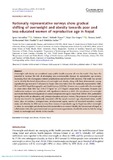Nationally representative surveys show gradual shifting of overweight and obesity towards poor and less-educated women of reproductive age in Nepal
Date
2020-03-27Publisher
Cambridge University PressAuthor
Sutradhar, IpsitaAkter, Tahmina
Hasan, Mehedi
Gupta, Rajat Das
Joshi, Hemraj
Haider, Mohammad Rifat
Sarker, Malabika
Metadata
Show full item recordCitation
Sutradhar, I., Akter, T., Hasan, M., Das Gupta, R., Joshi, H., Haider, M. R., & Sarker, M. (2020). Nationally representative surveys show gradual shifting of overweight and obesity towards poor and less-educated women of reproductive age in Nepal. Journal of Biosocial Science, doi:10.1017/S0021932020000152Abstract
Overweight and obesity are considered major public health concerns all over the world. They have the
potential to increase the risk of developing non-communicable diseases in reproductive age women,
increasing their risk of pregnancy related complications and adverse birth outcome. This study was carried
out to identify the trend of prevalence of overweight and obesity, along with their determinants, among
reproductive age women (15–49 years) in Nepal. Data were taken from the nationally representative 2006,
2011 and 2016 Nepal Demographic and Health Surveys (NDHSs). Women were considered to be overweight
or obese when their BMI was 23.0–27.5 kg/m2 or ≥27.5 kg/m2
, respectively. Univariate, bivariate and
multivariate analyses were performed, with significance taken at p<0.05. The prevalences of overweight
and obesity both showed rising trends in women of reproductive age in Nepal from 2006 to 2016, particularly
among those with no education, only primary education and poor women. The presence of overweight and
obesity was found to be significantly associated with the sample women’s age, educational status, wealth
index, place of residence, ecological zone, developmental region, number of household members, marital
status and ethnicity. In 2016 one in every three women of reproductive age in Nepal was either overweight
or obese. As overweight and obesity have detrimental effects on women’s health, the Government of Nepal, in
collaboration with other government and non-government organizations, should take action to halt the rising
trends in overweight and obesity in the country.

